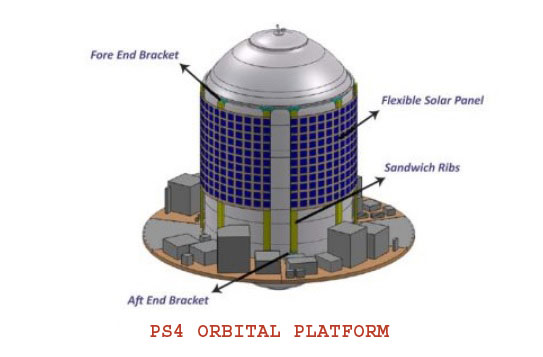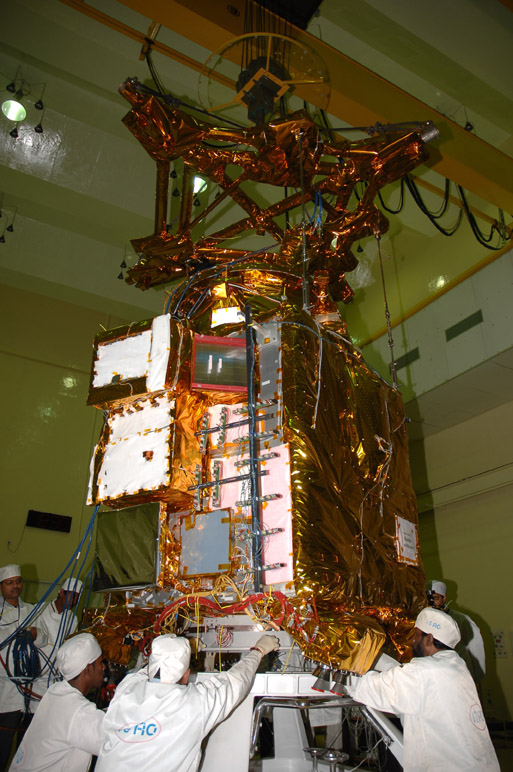 Chandrayaan-1, India's first mission to Moon, was launched successfully on
October 22, 2008 from SDSC SHAR, Sriharikota. The spacecraft was orbiting around the Moon at a
height of 100 km from the lunar surface for chemical, mineralogical and photo-geologic mapping
of the Moon. The spacecraft carries 11 scientific instruments built in India, USA, UK, Germany,
Sweden and Bulgaria.
Chandrayaan-1, India's first mission to Moon, was launched successfully on
October 22, 2008 from SDSC SHAR, Sriharikota. The spacecraft was orbiting around the Moon at a
height of 100 km from the lunar surface for chemical, mineralogical and photo-geologic mapping
of the Moon. The spacecraft carries 11 scientific instruments built in India, USA, UK, Germany,
Sweden and Bulgaria.
After the successful completion of all the major mission objectives, the orbit has been raised to 200 km during May 2009.
Results from Chandrayaan-1 Mission
| Mission | Remote Sensing, Planetary Science |
| Weight | 1380 kg (Mass at lift off) |
| Onboard power | 700 Watts |
| Stabilization | 3 - axis stabilised using reaction wheel and attitude control thrusters, sun sensors, star sensors, fibre optic gyros and accelerometers for attitude determination. |
| Payloads |
Scientific Payloads from India 1. Terrain Mapping Camera (TMC) 2. Hyper Spectral Imager (HySI) 3. Lunar Laser Ranging Instrument (LLRI) 4. High Energy X - ray Spectrometer (HEX) 5. Moon Impact Probe(MIP) Scientific Payloads from abroad 1. Chandrayaan-I X-ray Spectrometer (CIXS) 2. Near Infrared Spectrometer (SIR - 2) 3. Sub keV Atom Reflecting Analyzer (SARA) 4. Miniature Synthetic Aperature Radar (Mini SAR) 5. Moon Mineralogy Mapper (M3) 6. Radiation Dose Monitor (RADOM) |
| Launch Date | 22 October 2008 |
| Launch Site | SDSC, SHAR, Sriharikota |
| Launch Vehicle | PSLV C11 |
| Orbit | 100 km x 100 km : Lunar Orbit |
| Mission life | 2 Years |
PAYLOADS
Chandrayaan-2 mission is a highly complex mission, which represents a significant technological leap compared to the previous missions of ISRO. It comprised an Orbiter, Lander and Rover to explore the unexplored South Pole of the Moon. The mission is designed to expand the lunar scientific knowledge through detailed study of topography, seismography, mineral identification and distribution, surface chemical composition, thermo-physical characteristics of top soil and composition of the tenuous lunar atmosphere, leading to a new understanding of the origin and evolution of the Moon.
After the injection of Chandrayaan-2, a series of maneuvers were carried out to raise its orbit and on August 14, 2019, following Trans Lunar Insertion (TLI) maneuver, the spacecraft escaped from orbiting the earth and followed a path that took it to the vicinity of the Moon. On August 20, 2019, Chandrayaan-2 was successfully inserted into lunar orbit. While orbiting the moon in a 100 km lunar polar orbit, on September 02, 2019, Vikram Lander was separated from the Orbiter in preparation for landing. Subsequently, two de-orbit maneuvers were performed on Vikram Lander so as to change its orbit and begin circling the moon in a 100 km x 35 km orbit. Vikram Lander descent was as planned and normal performance was observed upto an altitude of 2.1 km. Subsequently communication from lander to the ground stations was lost.
The Orbiter placed in its intended orbit around the Moon will enrich our understanding of the moon’s evolution and mapping of the minerals and water molecules in Polar regions, using its eight state-of-the-art scientific instruments. The Orbiter camera is the highest resolution camera (0.3 m) in any lunar mission so far and will provide high resolution images which will be immensely useful to the global scientific community. The precise launch and mission management has ensured a long life of almost seven years instead of the planned one year.
Science experiments
Chandrayaan-2 has several science payloads to expand the lunar scientific knowledge through detailed study of topography, seismography, mineral identification and distribution, surface chemical composition, thermo-physical characteristics of top soil and composition of the tenuous lunar atmosphere, leading to a new understanding of the origin and evolution of the Moon.
The Orbiter payloads will conduct remote-sensing observations from a 100 km orbit while the Lander and Rover payloads will perform in-situ measurements near the landing site.

For understanding of the Lunar composition, it is planned to identify the elements and mapping its distribution on the lunar surface both at global and In-situ level. In addition detailed 3 dimensional mapping of the lunar regolith will be done. Measurements on the near surface plasma environment and electron density in the Lunar ionosphere will be studied. Thermo-physical property of the lunar surface and seismic activities will also be measured. Water molecule distribution will be studied using infra red spectroscopy, synthetic aperture radiometry & polarimetry as well as mass spectroscopy techniques.
PAYLOADS
Chandrayaan-3 is a follow-on mission to Chandrayaan-2 to demonstrate end-to-end capability in safe landing and roving on the lunar surface. It consists of Lander and Rover configuration. It will be launched by LVM3 from SDSC SHAR, Sriharikota. The propulsion module will carry the lander and rover configuration till 100 km lunar orbit. The propulsion module has Spectro-polarimetry of Habitable Planet Earth (SHAPE) payload to study the spectral and Polari metric measurements of Earth from the lunar orbit.
Mars Orbiter Mission is ISRO's first interplanetary mission to planet Mars with an orbiter craft designed to orbit Mars in an elliptical orbit of 372 km by 80,000 km. Mars Orbiter mission can be termed as a challenging technological mission and a science mission considering the critical mission operations and stringent requirements on propulsion, communications and other bus systems of the spacecraft. The primary driving technological objective of the mission is to design and realize a spacecraft with a capability to perform Earth Bound Manoeuvre (EBM), Martian Transfer Trajectory (MTT) and Mars Orbit Insertion (MOI) phases and the related deep space mission planning and communication management at a distance of nearly 400 million Km. S Autonomous fault detection and recovery also becomes vital for the mission...
Mission Profile
PSLV would inject the spacecraft from SDSC, SHAR in the 250 X 23000 km orbit with an inclination of 17.864 degree. As the minimum energy transfer opportunity from earth to mars occurs once in 26 months, the opportunity in 2013 demands a cumulative incremental velocity of 2.592 km/sec.
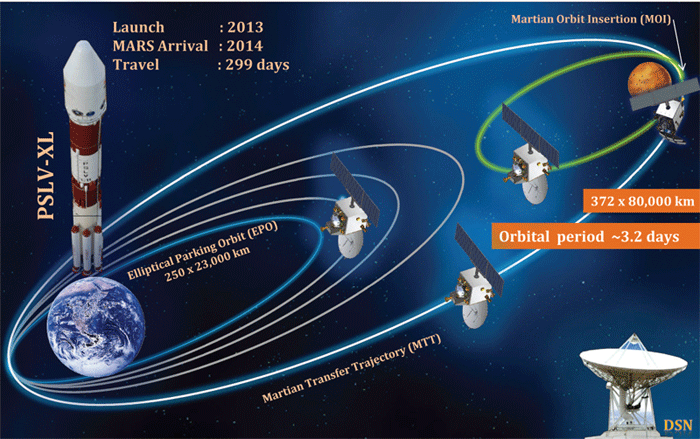
ISRO’s Advisory Committee for Space Sciences (ADCOS) has selected the following five payloads:
| Payload | Primary Objective |
|---|---|
| Lyman Alpha Photometer (LAP) | Escape processes of Mars upper atmosphere through Deuterium/Hydrogen |
| Methane Sensor for MARS (MSM) | Detect presence of Methane |
| Martian Exospheric Composition Explorer (MENCA) | Study the neutral composition of the Martian upper atmosphere |
| MARS Colour Camera (MCC) | Optical imaging |
| TIR imaging spectrometer (TIS) | Map surface composition and mineralogy |
The deployed views of the spacecraft indicating the scientific payloads are shown below.
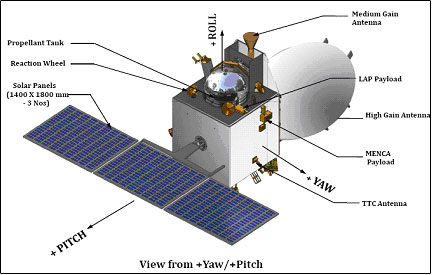
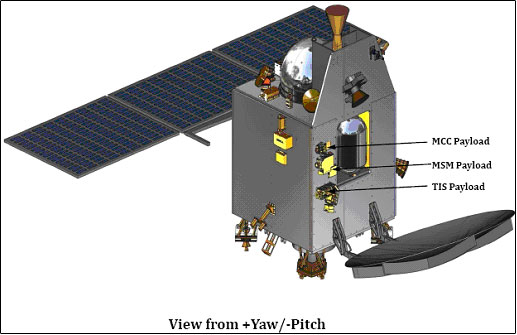
Planetary Science and Exploration (PLANEX) Programme
The objectives of the PLANEX programme are to conduct planetary science research, strengthen activities in this field in India and provide a forum for planning and implementation of planetary exploration missions of ISRO. PLANEX programme is nucleated at Physical Research Laboratory, Ahmedabad since 2001.
PAYLOADS
Orbital Platform Experiments in PSLV (PS4-OP) is a novel idea to use the spent PS4 stage (fourth stage of PSLV) as a 3 axis stabilized microgravity environment for short duration scientific experiments. This is intended to carry out in-orbit scientific experiments for an extended duration of 4-6 months for small scientific payloads. The advantage of the platform is that the stage has standard interfaces & packages for power generation, telemetry, tele-command, stabilisation, orbit keeping & orbit maneuvering.

